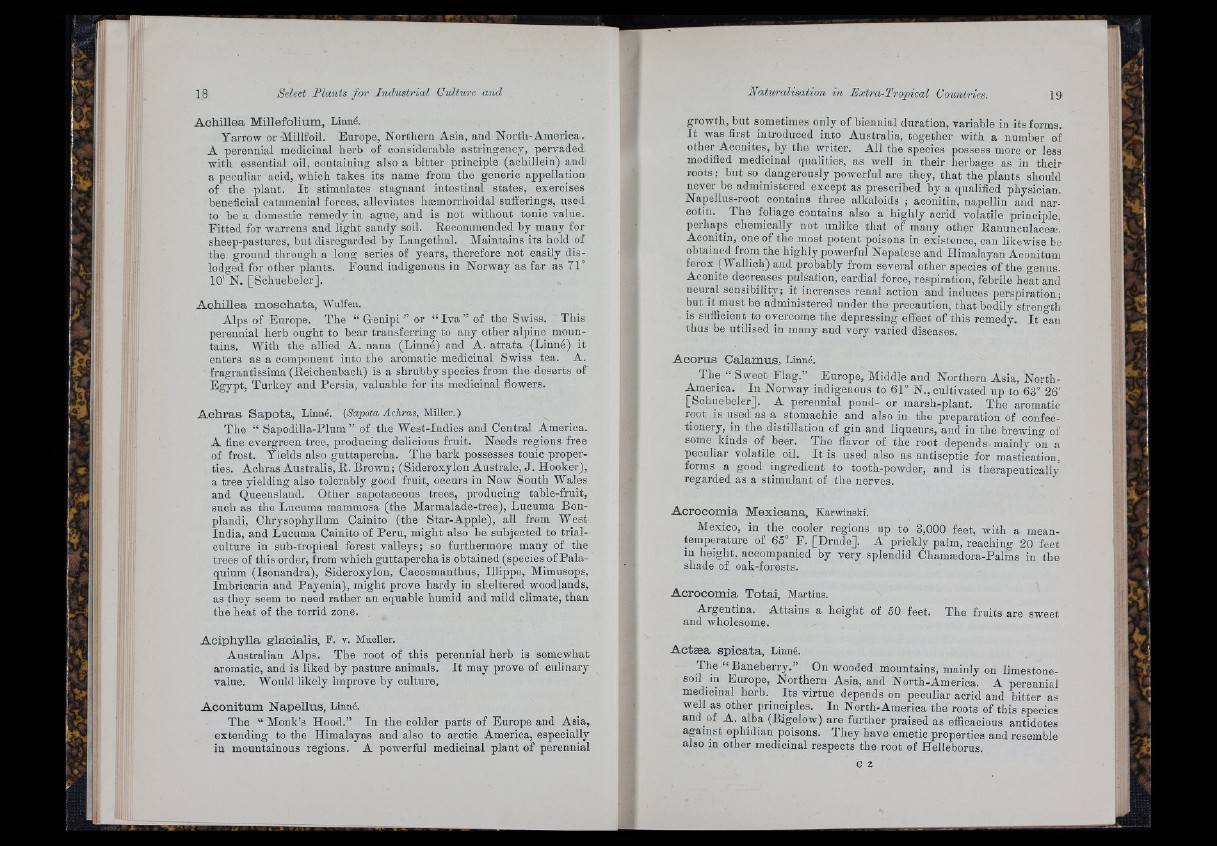
A c h ille a M ille fo lium , Linné.
Yarrow or-Millfoil. Europe, Northern Asia, and North-America.
A perennial medicinal herb of considerable astringency, pervaded
with essential oil, containing also a bitter principle (achillein) and
a peculiar acid, which takes its name from the generic appellation
of the plant. I t stimulates stagnant intestinal states, exercises
beneficial cataménial forces, alleviates hæmorrhoidal sufferings, used
to be a domestic remedy in ague, and is not without tonic value.
Fitted for warrens and light sandy soil. Recommended by many for
sheep-pastures, but disregarded by Langethal. Maintains its hold of
the ground through a long series of years, therefore not easily dislodged
for other plants. Found indigenous in Norway as far as 71°
10' N. [Schnebeler].
A c h ille a m o s c h a ta , Wulfen.
Alps of Europe. The “ Genipi ” or “ Iv a ” of the Swiss. This
perennial herb ought to bear transferring to any other alpine mountains.
With the allied A. nana (Linné) and A. a tra ta (Linné) it
enters as a component into the aromatic medicinal Swiss tea. A.
fragrantissima (Reichenbach) is a shrubby species from the deserts of
Egypt, Turkey and Persia, valuable for its medicinal flowers.
A o h r a s S a p o ta , Linné. (Sapota Achras, Miller.)
The “ Sapodilla-Plum ” of the West-Iudies and Central America.
A fine evergreen tree, producing delicious fruit. Needs regions free
of frost. Yields also guttapercha. The bark possesses tonic properties.
Achras Australis, R. Brown; ( SideroxyIon Australe, J . Hooker),
a tree yielding also tolerably good fruit, occurs in New South Wales
and Queensland. Other sapotaceous trees, producing table-fruit,
such as the Lucuma mammosa (the Marmalade-tree), Lucuma Bon-
plandi, Chrysophyllum Cainito (the Star-Apple), all from West
India, and Lucuma Cainito of Peru, might also be subjected to trial-
culture in sub-tropical forest valleys; so furthermore many of the
trees of this order, from which guttapercha is obtained (species of Pala-
quinm (Isonandra), Sideroxylon, Cacosmauthus, Illippe, Mimusops,
Inibricaria and Payenia), might prove hardy in sheltered woodlands,
as they seem to need rather an equable humid and mild climate, than
the heat of the torrid zone.
A c ip h y lla g la c ia lis, F. v. Mueller.
Australian Alps. The root of this perennial herb is somewhat
aromatic, and is liked by pasture animals. I t may prove of culinary
value. Would likely Improve by culture.
A c o n itum N a p e llu s , Linné.
The “ Monk’s Hood.” In the colder parts of Europe and Asia,
extending to the Himalayas and also to arctic America, especially
in mountainous regions. A powerful medicinal plant of perennial
growth, but sometimes only of biennial duration, variable in its forms.
I t was first introduced into Australia, together with a number of
other Aconites, by the writer. All the species possess more or less
modified medicinal qualities, as well in their herbage as in their
roots ; but so dangerously powerful are they, th a t the plants should
never be administered except as prescribed by a qualified physician.
Napellus-root contains three alkaloids ; aoonitin, napellin and narcotin.
The foliage contains also a highly acrid volatile principle,
perhaps chemically not unlike th a t of many other Ranunculaceæ.
Aconitin, one of the most potent poisons in existence, can likewise be
obtained from the highly powerful Nepalese aud Himalayan Aconitum
ferox (Wallich) and probably from several other species of the genus.
Aconite decrea,ses pulsation, cardial force, respiration, febrile heat aud
neural sensibility; it increases renal action and induces perspiration;
but it must be administered under the precaution, that bodily strength
is sufficient to overcome the depressing effect of this remedy. I t can
thus be utilised in many aud very varied diseases.
A c o ru s C a lam u s , Linné.
The “ Sweet Flag.” Europe, Middle and Northern Asia, North-
America. In Norway indigenous to 61° N., cultivated up to 63° 26'
[Schnebeler]. A perennial pond- or marsh-plant. The aromatic
root is used as a stomachic and also in the preparation of confectionery,
in the distillation of gin and liqueurs, aud in the brewing of
some kinds of beer. The flavor of the root depends mainly on a
peculiar volatile oil. I t is used also as antiseptic for mastication,
forms a good ingredient to tooth-powder, and is therapeutically
regarded as a stimulant of the nerves.
A c ro o om ia M e x ic a n a , Karwinski.
Mexico, in the cooler regions up to 3,000 feet, with a mean-
temperature of 65° F. [Crude]. A prickly palm, reaching 20 feet
in height, accompanied by very splendid Chamaidora-Palms in the
shade of oak-forests.
A c ro c om ia T o ta i, Martius.
Argentina. Attains a height of 50 feet. The fruits are sweet
and wholesome.
Aoteea s p ic a ta , Linné.
The “ Baneberry.” On wooded mountains, mainly on limestone-
soil m Europe, Northern Asia, aud North-America. A perennial
medicinal herb. Its virtue depends on peculiar acrid and bitter as
well as other principles. In North-America the roots of this species
and of A. alba (Bigelow) are further praised as efficacious antidotes
a p in s t ophidian poisons. They have emetic properties and resemble
also m other medicinal respects the root of Helleboriis.
C 2